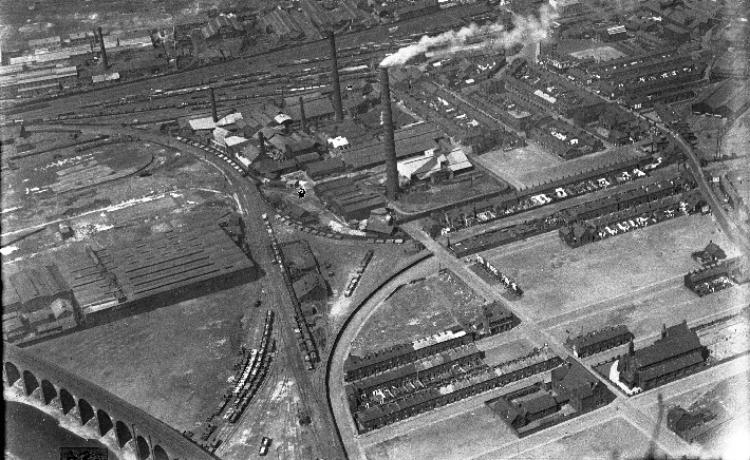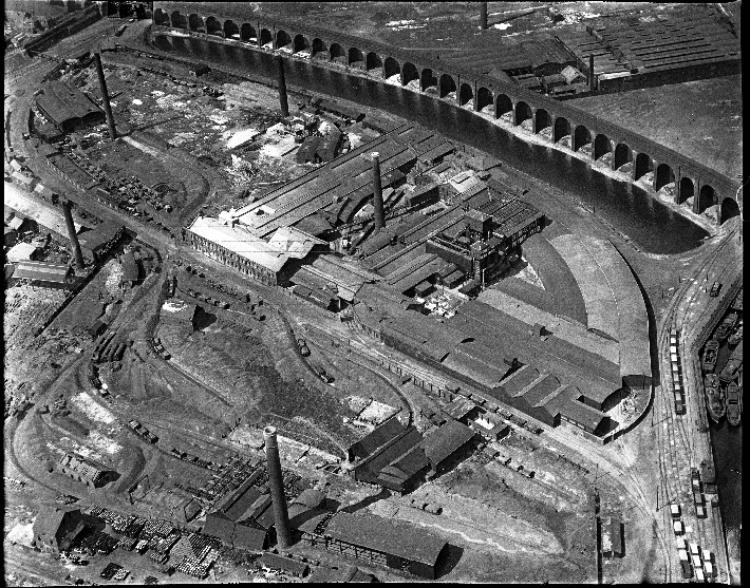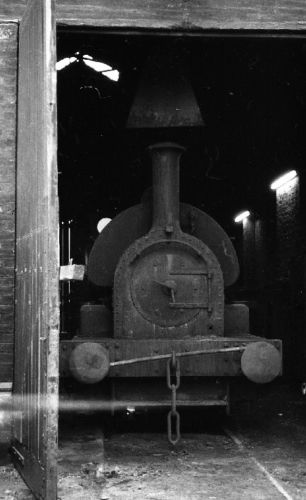
8D ASSOCIATION
The 8D Association is dedicated to promoting the history of the railways of South Lancashire, Merseyside and North Cheshire.
John Hutchinson’s West Bank Dock Estate
Widnes

Introduction.
John Hutchinson had made his fortune with the opening of a chemical works adjacent to the St Helens and Runcorn Gap Railway and the St Helens Canal at Spike Island. Having seen the operation of the new dock system at Spike Island he developed his own idea of an industrial area connected to both railways and waterway for the easy movement of both raw materials and finished products. He set about creating this area and it became the West Bank Estate.
The West Bank Dock Estate was to be situated primarily on two parcels of land known as Widnes Marsh and Hurst Marsh. The first portion of land he was to lease on 2nd June 1860 from John Lineaker Wright and William Beaumont for £ 135 per annum. This lease came with the strict condition that no chemical works could be situated within it. Written into the lease agreement was the option to purchase the land for £ 2,700 this option would be taken up on 2nd April 1870 releasing the Dock Estate from the terms of the lease. The second portion of land to be purchased was Widnes Marsh from Her Majesty The Queen on 4th January 1860 for £ 1,333 2s 6d. Prior to purchasing Widnes Marsh Hutchinson had been purchasing adjacent land. The final portion to be purchased was the foreshore onto the River Mersey on 22nd February 1865 this would allow construction of the dock and reclamation of further land for the Estate.
Before any significant development of the area could take place John Hutchinson sadly died on 24th March 1865. In his will he appointed William Norwood, James Cross and Thomas Part as Trustees and left clear instruction how the dock estate should be developed. The Trustees followed Hutchinson’s plan for development and slowly his vision became reality.

Agreement with the Railways.
On 20th April 1864 John Hutchinson entered into an agreement with the L.N.W.R. for the movement of goods to and from the estate. The agreement provided for the railway companies engines to use the Dock Estate system and for the Estates own locomotives to use certain sections of the Warrington to Garston line and sections of the St Helens and Runcorn Gap line. The connection with the Warrington to Garston line was adjacent to the Hutchinson Street yard and the St Helens and Runcorn Gap one was a junction south of the flat crossing at Widnes Dock Junction running on the north bank of the canal before passing through the Hutchinson No1 factory crossing Waterloo Road and running between the rear of the houses in Pitt Street and Milton Street.

(From the Ernie Brack collection). To view more of Ernie’s interesting Flickr photosteam click here
A further agreement was made between the Trustees and the L.N.W.R. on 6th October 1865 in relation to the building of the embankment and viaduct for the Ethefleda crossing a they would run through the estate. Only the land on which the viaduct piers would be sold and the Estate would retain ownership of the spaces between the piers. The majority of this land had been reclaimed with the construction of the dock.

(From the Ernie Brack collection). To view more of Ernie’s interesting Flickr photosteam click here
On 1st January 1881 the Hutchinson Trustees and the Sheffield and Midland Railway Company formed an agreement for construction of a line from the Widnes Loop. Again with the proviso that the Dock Estate would have access to the railway companies metals.
The Dock Complex.
The original dock opened in 1864 and was a simple affair in comparison to the finished article. Development of the dock complex spanned 50 years and was on going throughout. The Northern extension to the original dock took nearly 20 years to complete and followed the curve of the L.N.W.R. viaduct. The Outer Basin of the complex was also enlarged at the same time and both opened in 1883. The next phase of the dock expansion would be the branch dock which ran parallel with the River Mersey and was completed in 1886. Further expansion of the original dock took place in 1903 with the upper portion having an embankment constructed to allow a rail link to the Outer Basin this then created a dam on the upper portion which was to be converted with sheeting into a dock area but never was. This work was not carried out as the Outer Basin was now being used for the majority of trans shipping with the railway used for the flow of goods.

(From the Ernie Brack collection). To view more of Ernie’s interesting Flickr photosteam click here
The final major alteration to the dock came in 1914 and was the construction of a new dock entrance and the enlargement of the Outer Basin to the East.

(Reproduced with permission from the Industrial Railway Society)
Companies on the Estate.
Just some of the companies which leased land on the Estate.
W H Kershaw Timber Merchants was the earliest company on the Estate. Located on Hursts Marsh its lease was taken out on 20th January 1865 with a rent of £ 50 per annum. The company expanded and surrendered its original lease on 13th October 1874 with a new lease effective of the 14th. Rates of 1d per ton via rail and 2d per ton via the dock were quoted. The company closed in 1897 following the death of William Kershaw.
Thomas Vickers Phosphate Works leased a portion of land on 25th March 1873 and on 13th February 1895 it was purchased freehold along with adjoining plots. The works continued to grow until in 1936 they were taken over by Fisons.
Thomas Fleetwood The Phoenix Chemical Works and Snapes Chemical Works lease land to build an Alkali works from 10th July 1866. A rapid expansion of the works saw additional land leased over the next 5 years. With the death of George Fleetwood the Phoenix Chemical Works was sold to Thomas Snape, who had worked there since it opened, and in 1876 the works became known as the Snapes Chemical Works. The business would be sold to the United Alkali Company who in turn sold it on to Thomas Vickers.
Powell and Penny leased land on 1st June 1867 for the construction of a chemical works and was transferred to Golding Davis on 25th March 1899. The company was wound up in May 1891 and was subsequently sold to the United Alkali Company. The works would be amalgamated with the Mathieson works becoming known as the Marsh Alkali works. They were destroyed by fire in 1928.
Hall and Shaw leased land to construct a chemical works on 3rd September 1866 by George Hall and Robert Shaw. The company manufactured saltcake and bleaching powder. The company expanded in 1879 leasing further land from the Trustee and was taken over by the United Alkali Company on 28th February 1891. The United Alkali Company closed the site in 1903.
Mort and Cross Viaduct Chemical Works leased land 19th December 1872.
Robinson and Bancroft Atlas No2 Works leased land for their chemical works on 15th September 1873. They were soda manufacturers and copper smelters. Using the Leblanc process in the production of Alkali. Recently the site has been cleared with Halton Borough Council footing the bill for the clean up process.
Wells and Galloway (business unknown) leased land adjacent to the Warrington to Garston line on 1st July 1874. They were purchased by the L.N.W.R. in 1891 and their site was used for additional sidings.

W Christie and Company leased land on 10th April 1886 and was an importer of railway sleepers.
Anglesey Limestone Limited leased land for a limestone depot on 1st Jan 1888 on a yearly lease of £ 38 5s 0d.
Sanite and Company leased land on 27th July 1888 soap manufactures from Bristol closing in 1895/96.
Thomas Norman Pottery leased land on 16th December 1890 Frederick John Norman, Alfred Robert Norman and Herbert Thomas Norman potters of Runcorn.
Craigs Cast Heading Company leased land in 1891 Timber Merchants of Renfrew Scotland.
Bowman and Company Victoria Chemical Works 18th February 1897 lease cancelled by Trustees in 1904
Ditton Oils leased land on 19th May 1900 they manufactured Elastic Pitch and Stearine.
Greenway Brothers 24th June 1906 situated on the site of the former W H Kershaw site.
Granox Limited leased land on 30th August 1928 for the manufacture of Poultry food, cattle food and fat manufacture.
Mersey Casings and By Products leased land on 13th August 1935 for the manufacture of poultry meals, pig food and sausage casings. An additional site was leased on 1st July 1949.
Fisons Limited leased additional land from 25th March 1947 on the site of the Thomas Vickers Works.

Reproduced with permission from the Industrial Railway Society.
United Alkali Company West Bank Power Station leased land from 29th September 1917 for the construction of a power station supplied with coal by rail and water from the River Mersey the power station was operational by November 1920. By the late 1950’s the power station was owned and operated by ICI and would only close in the 1970’s being demolished in the early 1980’s.

1948 to the present day.
By 1948 the Dock Estate comprised of 280 acres with 175 in industrial use. It earned around £ 8,800 per annum 65 acres of land were allocated for industrial waste and 40 acres were available for industrial development.
The docks were still busy too handling sand, stone, fertilizers, chemicals coal, asbestos and cement products.
The Estates railway system was around 12 ½ miles in length and it employed 3 steam locomotives. Several of the companies on the Estate had their own fleets of locomotives for shunting purposes. Latterly the Estate converted to diesel shunters but would retain a single steam loco to cover duties when the diesels were unavailable. The vast majority of the Dock Estate’s railway system closed on 29th May 1968 but some sites were still served by the dock estate until around 1977. The Fisons plant still used a single shunter for the despatch of goods via a part of the internal railway system until 1981.
The connections with the national rail network were to slowly close the first being the connection with the ex St Helens and Runcorn Gap Railway. Secondly the connection to the Sheffield and Midland Joint was to close on 20th August 1960. This left the connection with the ex LNWR deviation line at Hutchinson Street yard which soldiered on until the early 1980’s handling traffic from the Fisons works.


By the late 20th Century the area was being re-developed and several road based logistics companies have set up warehouses on the former West Bank Dock Estate. Notably the supermarket Tesco has a large distribution centre and the Eddie Stobart inland port now stands on part of the site.
